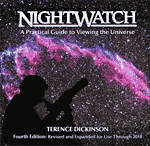|
1
|
Moon near the Pleiades (evening sky) at 21h UT.
• Pleiades (star cluster) (Wikipedia)
|
|
2
|
Moon near Aldebaran (evening sky) at 17h UT.
|
|
7
|
Moon near Beehive cluster (evening sky) at 1h UT.
|
|
7
|
Mercury at superior conjunction with the Sun at 9h UT. The planet passes into the evening sky.
|
|
7
|
Full Moon at 21:55 UT.
• Full Moon Names (Wikipedia)
|
|
8
|
Alpha Centaurids meteor shower peaks. About 6 meteors/hour but can peak at up to 25/hour. Produces bright, fast meteors. Active Jan 28 to Feb 21. A sometimes major southern shower. Poor viewing conditions this year due to excessive moonlight.
• The Alpha & Beta Centaurids (Gary Kronk)
|
|
8
|
Moon near Regulus (morning sky) at 19h UT.
|
|
10
|
Venus 0.3° NNW of Uranus (41° from Sun, evening sky) at 1h UT. Mags. -4.1 and +5.9.
|
|
11
|
Moon at perigee (closest to Earth) at 19h UT (367,922 km; 32.5').
|
|
12
|
Moon near Spica (morning sky) at 12h UT.
|
|
12
|
Moon near Saturn (morning sky) at 22h UT. Mag. +0.5.
|
|
14
|
Last Quarter Moon at 17:05 UT.
|
|
15
|
Moon near Antares (morning sky) at 19h UT.
|
|
21
|
New Moon at 22:36 UT. Start of lunation 1103.
• Lunation Number (Wikipedia)
|
|
25
|
Moon near Venus (44° from Sun, evening sky) at 21h UT. Mag. -4.2.
|
|
27
|
Moon near Jupiter (evening sky) at 3h UT. Mag. -2.2.
|
|
27
|
Moon at apogee (farthest from Earth) at 14h UT (distance 404,863 km; angular size 29.5').
|
|
29
|
Moon near the Pleiades (evening sky) at 2h UT.
• Pleiades (star cluster) (Wikipedia)
|
|
|
The Zodiacal Light is caused by sunlight reflected off meteoric dust in the plane of the solar system. Choose a clear, moonless night, about 1-2 hours after sunset, and look for a large triangular-shaped glow extending up from the horizon
(along the ecliptic). The best months to view the Zodiacal Light is when the ecliptic is almost vertical at the horizon: March and April (evening) and October-November (morning); times reversed for the southern hemisphere.
• Zodiacal Light (Wikipedia)
• Astronomy Picture of the Day (APOD)
• Photographing the Zodiacal Light (Weatherscapes)
|
|
All times Universal Time (UT). USA Eastern Standard Time = UT - 5 hours.
|






